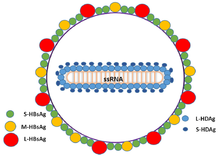Hepatitis D
| Hepatitis D | |
|---|---|
| Classification and external resources | |
| Specialty | infectious disease |
| ICD-10 | B17.0, B18.0 |
| ICD-9-CM | 070.31 |
| DiseasesDB | 5792 |
| MeSH | D003699 |
| Hepatitis D | |
|---|---|
 |
|
| Schematic representation of the hepatitis delta virus virion. | |
| Virus classification | |
| Group: | Group V ((−)ssRNA) |
| Order: | Unassigned |
| Family: | Unassigned |
| Genus: | Deltavirus |
| Species: | Hepatitis delta virus |
| Hepatitis delta virus delta antigen | |||||||||
|---|---|---|---|---|---|---|---|---|---|

oligomerization domain of hepatitis delta antigen
|
|||||||||
| Identifiers | |||||||||
| Symbol | HDV_ag | ||||||||
| Pfam | PF01517 | ||||||||
| InterPro | IPR002506 | ||||||||
| SCOP | 1a92 | ||||||||
| SUPERFAMILY | 1a92 | ||||||||
|
|||||||||
| Available protein structures: | |
|---|---|
| Pfam | structures |
| PDB | RCSB PDB; PDBe; PDBj |
| PDBsum | structure summary |
Hepatitis D (hepatitis delta) is a disease caused by the hepatitis D virus (HDV), a small spherical enveloped viroid. This is one of five known hepatitis viruses: A, B, C, D, and E. HDV is considered to be a subviral satellite because it can propagate only in the presence of the hepatitis B virus (HBV). Transmission of HDV can occur either via simultaneous infection with HBV (coinfection) or superimposed on chronic hepatitis B or hepatitis B carrier state (superinfection).
Both superinfection and coinfection with HDV results in more severe complications compared to infection with HBV alone. These complications include a greater likelihood of experiencing liver failure in acute infections and a rapid progression to liver cirrhosis, with an increased risk of developing liver cancer in chronic infections. In combination with hepatitis B virus, hepatitis D has the highest fatality rate of all the hepatitis infections, at 20%.
The HDV is a small, spherical virus with a 36 nm diameter. It has an outer coat containing three kinds of HBV envelope protein - large, medium, and small hepatitis B surface antigens - and host lipids surrounding an inner nucleocapsid. The nucleocapsid contains single-stranded, circular RNA of 1679 nucleotides and about 200 molecules of hepatitis D antigen (HDAg) for each genome. The central region of HDAg has been shown to bind RNA. Several interactions are also mediated by a coiled-coil region at the N terminus of HDAg. The hepatitis D circular genome is unique to animal viruses because of its high GC nucleotide content. The HDV genome exists as an enveloped, negative sense, single-stranded, closed circular RNA. Its nucleotide sequence is 70% self-complementary, allowing the genome to form a partially double-stranded, rod-like RNA structure. With a genome of approximately 1700 nucleotides, HDV is the smallest "virus" known to infect animals. It has been proposed that HDV may have originated from a class of plant pathogens called viroids, which are much smaller than viruses.
...
Wikipedia
